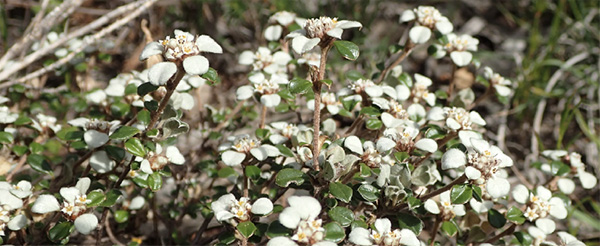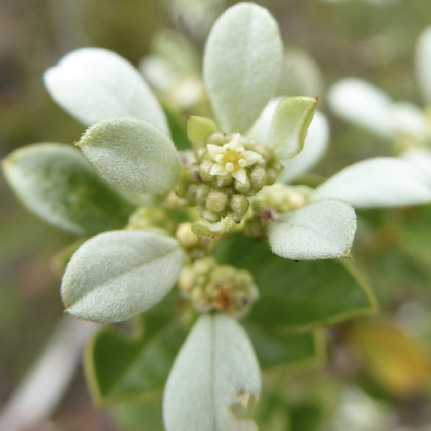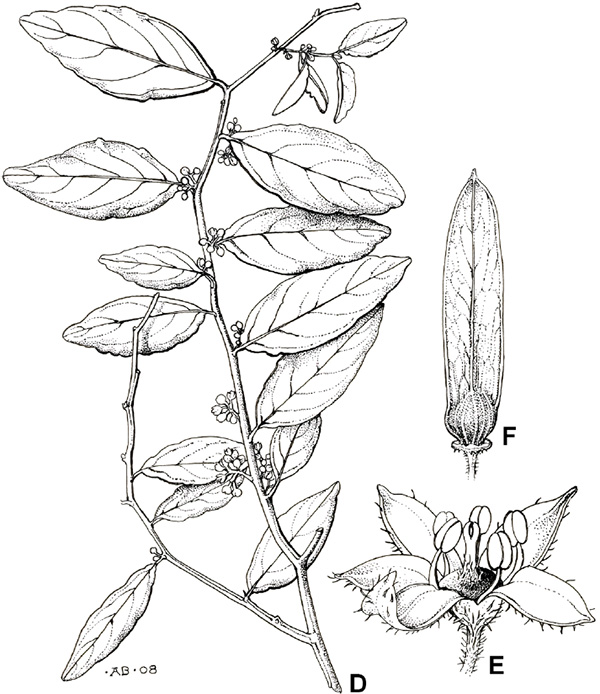
Stenanthemum leucophractum, growing in Wanilla Settlement Reserve (Eyre Peninsula). Photo: J. Kellermann.
The State Herbarium of South Australia published three articles in Vol. 35 of its journal Swainsona online, today, 7 April 2021. In these articles, State Herbarium botanist Dr Jürgen Kellermann and colleagues, continue the publication of results of the research project on Australian Rhamnaceae, which is funded by the Australian Biological Resources Study, Canberra (ABRS).
(1) J. Kellermann, Further lectotypifications and nomenclatural notes on Rhamnaceae from northern Australia. (8mb PDF).
In this paper, the nomenclature and typification of seven species of Rhamnaceae from genera occuring in northern Australia, is discussed and lectotypes are chosen for some of them. Several species are illustrated with excellent line-drawings by Anita Barley (see below).
(2) J. Kellermann & K.R. Thiele, The other ‘propeller plant’ – Notes on Stenanthemum Reissek (Rhamnaceae: Pomaderreae) and a key to the genus in Australia. (3.2mb PDF).
The genus Stenanthemum was reinstated by Western Australian botanist Barbara Rye, who also published several new species in 1995, 2001 and 2007. While she provided detailed descriptions of all new species and subspecies, no recent descriptions are available for most of the already existing taxa. These ten plants are treated in this paper by Jürgen Kellermann and Kevin Thiele, who also select lectotypes for most of them and present a key to all species of the genus in Australia.
(3) J. Kellermann, The importance of the ‘h’ – Parahomonymy in Trymalium (Rhamnaceae: Pomaderreae. (2.2mb PDF).

Spyridium daphnoides, formerly known as S. spathulatum, from Deep Creek Conservation Park (Fleurieu Peninsula). Photo: J. Kellermann.
The history of the species names Trymalium spatulatum (Labill.) G.Don from Western Australia and T. spathulatum F.Muell., the basionym of Spyridium spathulatum (F.Muell.) Benth., from South Australia is discussed. The author concludes that the names are so similar that they are likely to be confused and that they should be treated as homonyms under the International Code of Nomenclature (ICN). This means that the current name for the South Australian species is illegitimate and needs to be replaced by the new combination S. daphnoides (Reissek) Kellermann, which is published in this paper.
To access content of all volumes of Swainsona and the Journal of the Adelaide Botanic Gardens since Vol. 1 (1976), please visit the journal’s web-site at flora.sa.gov.au/swainsona.
In addition, in February, Collaborator Francis Nge published a detailed phylogeny and biogeographical analysis of Pomaderris, the largest genus of Rhamnaceae in Australia (which also extends to New Zealand). This paper was part of his PhD thesis on the evolution of the Australian flora across the southern temperate regions of the continent, which he recently submitted.
F.J. Nge, J. Kellermann, E. Biffin, M. Waycott & K.R. Thiele (2021). Historical biogeography of Pomaderris (Rhamnaceae): Continental vicariance in Australia and repeated independent dispersals to New Zealand. Molecular Phylogenetics and Evolution 158: article 107085 (11 pp.).
Written by State Herbarium botanist J. Kellermann.


